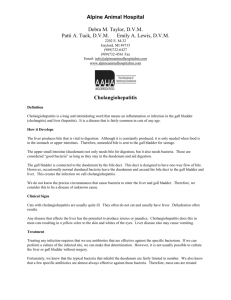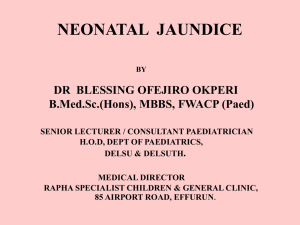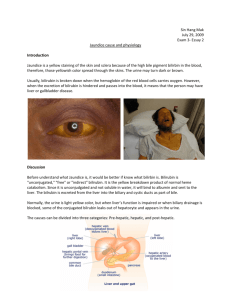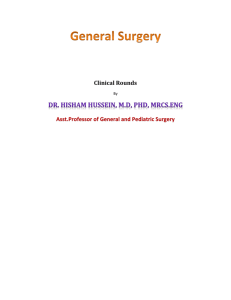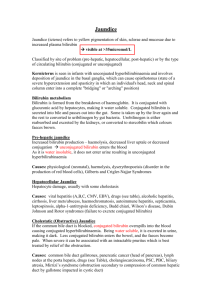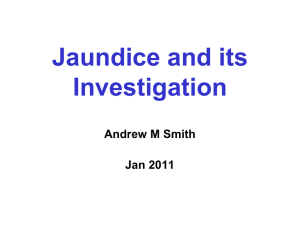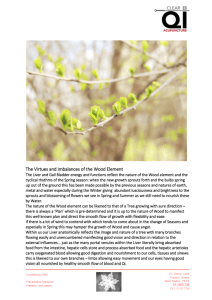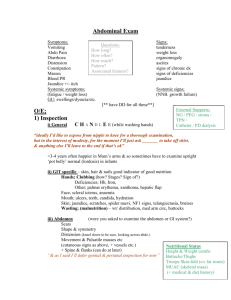Old Yeller Could Have Been A Cat Too
advertisement
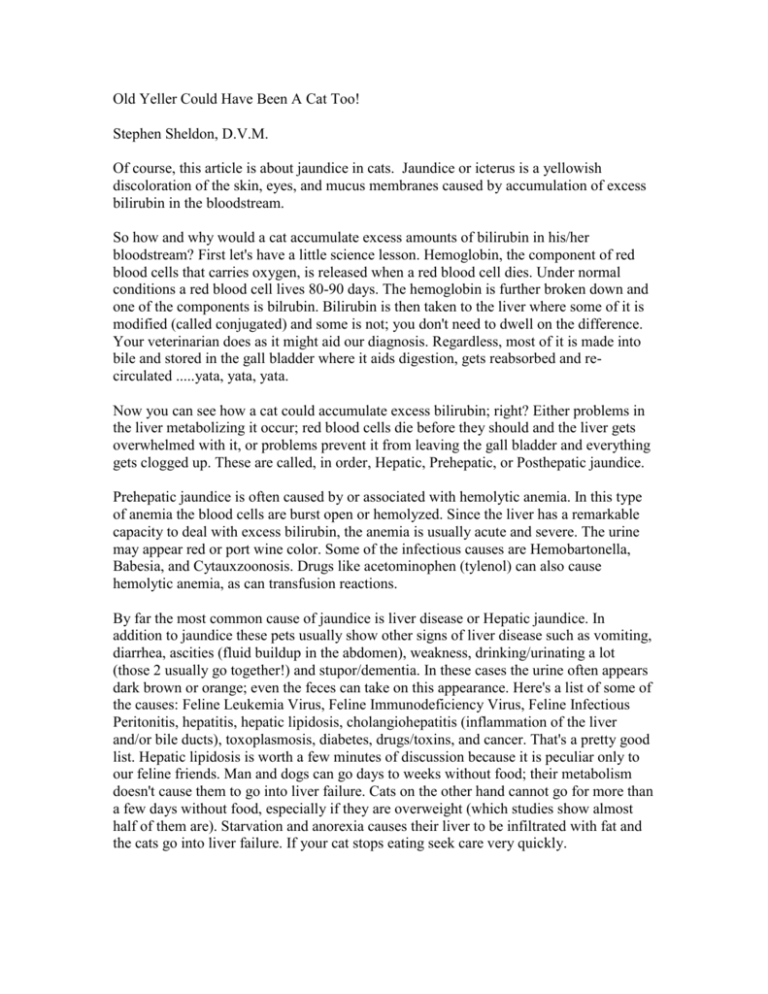
Old Yeller Could Have Been A Cat Too! Stephen Sheldon, D.V.M. Of course, this article is about jaundice in cats. Jaundice or icterus is a yellowish discoloration of the skin, eyes, and mucus membranes caused by accumulation of excess bilirubin in the bloodstream. So how and why would a cat accumulate excess amounts of bilirubin in his/her bloodstream? First let's have a little science lesson. Hemoglobin, the component of red blood cells that carries oxygen, is released when a red blood cell dies. Under normal conditions a red blood cell lives 80-90 days. The hemoglobin is further broken down and one of the components is bilrubin. Bilirubin is then taken to the liver where some of it is modified (called conjugated) and some is not; you don't need to dwell on the difference. Your veterinarian does as it might aid our diagnosis. Regardless, most of it is made into bile and stored in the gall bladder where it aids digestion, gets reabsorbed and recirculated .....yata, yata, yata. Now you can see how a cat could accumulate excess bilirubin; right? Either problems in the liver metabolizing it occur; red blood cells die before they should and the liver gets overwhelmed with it, or problems prevent it from leaving the gall bladder and everything gets clogged up. These are called, in order, Hepatic, Prehepatic, or Posthepatic jaundice. Prehepatic jaundice is often caused by or associated with hemolytic anemia. In this type of anemia the blood cells are burst open or hemolyzed. Since the liver has a remarkable capacity to deal with excess bilirubin, the anemia is usually acute and severe. The urine may appear red or port wine color. Some of the infectious causes are Hemobartonella, Babesia, and Cytauxzoonosis. Drugs like acetominophen (tylenol) can also cause hemolytic anemia, as can transfusion reactions. By far the most common cause of jaundice is liver disease or Hepatic jaundice. In addition to jaundice these pets usually show other signs of liver disease such as vomiting, diarrhea, ascities (fluid buildup in the abdomen), weakness, drinking/urinating a lot (those 2 usually go together!) and stupor/dementia. In these cases the urine often appears dark brown or orange; even the feces can take on this appearance. Here's a list of some of the causes: Feline Leukemia Virus, Feline Immunodeficiency Virus, Feline Infectious Peritonitis, hepatitis, hepatic lipidosis, cholangiohepatitis (inflammation of the liver and/or bile ducts), toxoplasmosis, diabetes, drugs/toxins, and cancer. That's a pretty good list. Hepatic lipidosis is worth a few minutes of discussion because it is peculiar only to our feline friends. Man and dogs can go days to weeks without food; their metabolism doesn't cause them to go into liver failure. Cats on the other hand cannot go for more than a few days without food, especially if they are overweight (which studies show almost half of them are). Starvation and anorexia causes their liver to be infiltrated with fat and the cats go into liver failure. If your cat stops eating seek care very quickly. Posthepatic jaundice only has a few causes; most of them are related to compression of the gall bladder ducts. Pancreatitis or tumors of the pancreas can often cause this as the gall bladder ducts run near the pancreas on their way to emptying in the duodenum. If the bile ducts are completely blocked the stools may become gray colored. Complete obstruction can also cause bleeding disorders as vitamin K absorption is decreased. Besides pancreatitis and tumors, gallbladder stones can cause obstruction. One very common cause is cholangiohepatitis, inflammation of the liver and gall bladder, the cause for which is not known for sure. Liver flukes can also cause obstruction of the gall bladder ducts. To diagnose the cause of jaundice in your cat some lab tests are in order. The minimum tests you should expect are: complete blood cell counts, serum biochemistries, urinalysis, thyroid tests (older cats), and abdominal radiographs (x-rays). If a hemolytic anemia is suspected, tests for autoimmune diseases (coombs, ANA, RF) will be run, as will tests for blood parasites and viral infections. Hepatic jaundice will require further testing in the area of the liver: bile acid tests and an abdominal ultrasound with or without liver biopsy are recommended. The same tests are indicated for post-hepatic jaundice in addition to checking blood amylase and lipase levels (which were probably ordered in the serum chemistries). Once the cause is determined we can devise a treatment plan. Hemolytic anemias are treated by killing the blood-borne parasites or using heavy doses of immunosuppressive drugs like cortisone, cyyclophosphamide or azathioprine. Hepatitis is treated by using supportive care such as intravenous fluids, antibiotics, and forced/tube feedings. Hepatitis and cholangiohepatitis can be difficult to treat as there is no "magic bullet" for these diseases. Deshydrocholic acid can be used to help improve bile flow through the gall bladder ducts. If GI ulceration occurs we use drugs like cimetidine, ranitidine, and sucralfate. For cats with hepatic lipidosis it is critical to survival to begin getting food in these cats immediately. This involves force feeding, nasoesophageal intubation (NE tube) or a gastrotomy tube. Cats tolerate the NE tube fairly well and it's easy to maintain. Diet is also important in treating jaundice. An ideal diet is Hill K/D. Diets for hepatic disease should be low in protein and have more of the calories coming from fat and carbohydrates. If your cat has a hemolyitc anemia a diet higher in protein is recommended as protein helps build red blood cells. The prognosis depends on what caused the jaundice. Most cats are young cats about 4 years old. Some studies showed over 50% of cats with icterus died or were euthanized; these are not good numbers. Early diagnosis and treatment most assuredly will help the odds if you cat becomes icteric

